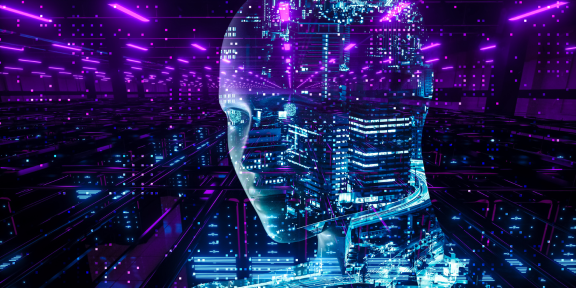What is Artificial Intelligence (AI): Everything You Need To Know

Artificial Intelligence (AI) is a rapidly evolving field that has captured the imagination of researchers, businesses, and the general public alike. From self-driving cars to AI-powered chatbots, AI technology is transforming the way we live, work, and interact with the world. In this comprehensive guide, we will explore the meaning of AI, its history, applications, and potential future developments. We will also answer some common questions about AI and discuss its ethical implications.
What Exactly is AI?
AI, or Artificial Intelligence, refers to the ability of a computer system or machine to perform tasks that typically require human intelligence. These tasks include learning, reasoning, problem-solving, understanding language, and recognizing patterns. AI technology aims to create machines that can imitate, enhance, or even surpass human intelligence.
AI has its roots in computer science, mathematics, and cognitive psychology. It combines these disciplines to build intelligent systems capable of processing vast amounts of data, recognizing patterns, and making informed decisions based on that information.

What Does AI Stand for in Technology?
In technology, AI stands for Artificial Intelligence, a field that focuses on creating intelligent machines capable of performing tasks that usually require human intelligence. It is an interdisciplinary field encompassing various subfields, such as machine learning, deep learning, and natural language processing.
Machine Learning
Machine learning is a subset of AI that enables computers to learn from data without being explicitly programmed. It focuses on developing algorithms that can identify patterns in data, make predictions, and improve their performance over time. Machine learning techniques can be categorized into three main types: supervised learning, unsupervised learning, and reinforcement learning.
Supervised Learning
In supervised learning, AI systems are trained using labeled examples provided by humans. These examples are used to teach the system to recognize specific patterns, such as images of circles and squares or customer purchasing behavior. Once trained, the system can make predictions or classifications based on new, unseen data.
Unsupervised Learning
Unsupervised learning, on the other hand, involves algorithms that identify patterns in data without any prior labeling or categorization. These algorithms cluster data points based on their similarities, enabling the system to group similar items together, such as fruits with similar weights or cars with similar engine sizes.
Reinforcement Learning
Reinforcement learning is a type of AI where the system learns to maximize a reward based on its input data. Through trial and error, the system learns to make optimal decisions, eventually becoming capable of performing complex tasks without human intervention.
Deep Learning
Deep learning is a subfield of machine learning that uses artificial neural networks to model high-level abstractions in data. These networks are inspired by the structure and function of the human brain, allowing deep learning systems to process and interpret complex data, such as images, speech, and text.

The History of AI
There is a long history of AI, even though it may seem fairly new to us non-techy people. AI as a field of study can be traced back to the early 20th century, with Alan Turing’s seminal work, “Computing Machinery and Intelligence,” published in 1950. Turing proposed the “Turing Test,” a method for determining whether a machine can think like a human.
The term “Artificial Intelligence” was coined in 1956 by John McCarthy, who defined it as “the science and engineering of making intelligent machines, especially intelligent computer programs.” Over the years, AI research has gone through several cycles of hype and disillusionment, with major breakthroughs in machine learning, deep learning, and natural language processing fueling renewed interest and progress.
AI in Real Life: Applications and Examples
AI is increasingly being integrated into various aspects of our daily lives, from chatbots and navigation apps to wearable fitness trackers and personalized marketing campaigns. Here are some examples of AI in real life:
ChatGPT
ChatGPT is an AI-powered chatbot capable of generating human-like written content in various formats, such as essays, code, and answers to questions. Developed by OpenAI, ChatGPT leverages advanced language models to emulate human writing.
Google Maps
Google Maps uses AI algorithms to analyze location data from smartphones and user-reported information to determine the fastest routes, monitor traffic conditions, and provide real-time navigation updates.
Smart Assistants
AI-powered personal assistants like Siri, Alexa, and Cortana use natural language processing to understand and respond to user commands, such as setting reminders, searching the internet, and controlling smart home devices.
Snapchat Filters
Snapchat filters use machine learning algorithms to distinguish between a subject and its background, track facial movements, and apply real-time image adjustments based on user actions.
Self-Driving Cars
Self-driving cars employ deep learning algorithms to detect objects, recognize traffic signals, estimate distances, and make decisions based on real-time data.
Wearables
Wearable devices in healthcare use AI technology to monitor vital signs, such as blood pressure, heart rate, and blood glucose levels, and predict potential health risks based on historical data.
MuZero
MuZero, a computer program developed by DeepMind, is a cutting-edge example of AI capable of mastering games it has not been explicitly taught to play, such as chess and various Atari games, through brute force and millions of iterations.

What is the Most Advanced AI?
The most advanced AI systems are those that can perform complex tasks with minimal human intervention or supervision, learn from their mistakes, and adapt to new situations. Some examples of advanced AI include Google’s AlphaGo, which defeated world-class Go player Lee Sedol in 2016, and OpenAI’s GPT-3, a powerful language model capable of generating human-like text and understanding natural language.
The Future of AI: Challenges and Opportunities
As AI technology continues to advance, we can expect to see even more sophisticated applications and systems capable of tackling complex problems and tasks. However, the development and widespread adoption of AI also come with challenges, such as ensuring data privacy, addressing ethical concerns, and preventing the misuse of AI for malicious purposes.
Ethical AI
The increasing use of AI in various domains raises ethical questions about fairness, transparency, and accountability. Ensuring that AI systems are designed and implemented in a way that respects human values and promotes social good is essential for maintaining public trust in AI technology.
AI and the Workforce
As AI becomes more capable and widespread in the workplace, concerns about job displacement and the need for re-skilling have emerged. Preparing the workforce for the AI-driven future will require investments in education, training, and lifelong learning opportunities.
The Role of Government and Industry
The development and application of AI technology will likely require collaboration between governments, businesses, and research institutions. Establishing regulatory frameworks, promoting responsible AI practices, and fostering innovation will be crucial for unlocking the full potential of AI.
Artificial Intelligence Wrap Up
As you can see, AI is large and growing field. Artificial intelligence can be used in a number of different areas of our life currently, with more areas expected in the future. While it may be a bit daunting, getting started with Artificial Intelligence can only benefit you and your business.

Frequently Asked Questions
Q: What is the AI robot?
A: An AI robot is a machine equipped with artificial intelligence technology that allows it to perform tasks autonomously, learn from experience, and adapt to new situations. AI robots can be found in various industries, such as manufacturing, healthcare, and logistics.
Q: What is an example of AI?
A: Examples of AI technology include voice-activated smart assistants like Siri and Alexa, recommendation algorithms used by streaming services like Netflix, and AI-powered customer service chatbots.
Q: What is the most advanced AI?
A: Some of the most advanced AI systems include Google’s AlphaGo, which defeated world-class Go player Lee Sedol in 2016, and OpenAI’s GPT-3, a powerful language model capable of generating human-like text and understanding natural language.
Q: How does AI technology impact our daily lives?
A: AI technology has become increasingly integrated into our daily lives, from chatbots and navigation apps to wearable fitness trackers and personalized marketing campaigns. These applications help us stay connected, make informed decisions, and lead more efficient lives.
Q: What are the challenges and opportunities associated with AI technology?
A: Challenges associated with AI technology include ensuring data privacy, addressing ethical concerns, and preventing the misuse of AI for malicious purposes. Opportunities include the development of more sophisticated applications and systems capable of tackling complex problems and tasks, as well as the potential for AI to transform industries and improve the quality of life for people around the world.
